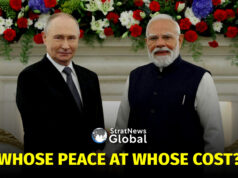
When North Korea tested an intercontinental ballistic missile on July 4, 2017, followed weeks later by a hydrogen bomb, the speed of its progress caught U.S. intelligence by surprise. That shock, as Lauren Cho explains in her analysis for the Bulletin of the Atomic Scientists, was not a one-off failure but part of a recurring pattern that has left Washington reacting rather than anticipating.
Cho writes that North Korea has repeatedly outmanoeuvred U.S. agencies through two main tactics — deception and exploitation of bureaucracy. The regime shows what it wants the world to see, hides what it must, and manipulates timing to shape foreign perceptions. Meanwhile, U.S. intelligence, slowed by rigid systems and old assumptions, often misreads the signals.
This is not new. From the 1994 Agreed Framework to the later Six-Party Talks, Washington believed it had frozen Pyongyang’s nuclear ambitions. Yet as international inspectors watched symbolic gestures like the demolition of the Yongbyon cooling tower, North Korean scientists quietly advanced uranium-enrichment elsewhere. Each cycle ended the same way: partial disclosure, misplaced optimism, and eventual surprise.
According to Cho, this happens because U.S. intelligence relies heavily on what can be counted or photographed — satellite images, missile parts, launch sites. North Korea, knowing this, manages visibility itself. It reveals just enough to mislead. “The less they show, the more confident the U.S. becomes in its incomplete picture,” Cho notes in the Bulletin piece.
The issue also runs deeper inside U.S. institutions. Analysts tend to favour established assessments and are hesitant to challenge them without overwhelming evidence. Once a consensus forms — such as the 2017 belief that Pyongyang was years away from an operational ICBM — it becomes hard to revise. This “institutional inertia”, Cho says, blinds intelligence agencies to fast-moving realities.
Pressure from policymakers makes it worse. Decision-makers often demand clear answers and timelines, leaving little room for uncertainty. To satisfy them, intelligence reports can overstate confidence in unclear data. For a country like North Korea, whose entire strategy is built on secrecy and confusion, that overconfidence works perfectly.
Cho argues that the U.S. needs to rethink how it gathers and interprets intelligence. She outlines three priorities. First, build flexible systems that reward questioning and tolerate changing assessments. Second, expand expertise beyond technology — analysts need to understand North Korea’s culture, language, and leadership style to decode its moves. And third, be open about uncertainty so that policymakers prepare for multiple outcomes rather than one neat prediction.
The article points out that deception is not unique to North Korea. Russia and China also use strategic ambiguity to hide or distort their capabilities. But Pyongyang has refined it into a survival tool — controlling uncertainty to deter attack while maintaining leverage in negotiations.
The lesson, Cho concludes, is that intelligence failure is not inevitable but preventable. “Deception will always exist,” she writes, “but surprise doesn’t have to.” For that, the U.S. must learn to adapt faster than its adversary and question its own habits of thought as sharply as it questions others’.
In a career spanning three decades and counting, Ramananda (Ram to his friends) has been the foreign editor of The Telegraph, Outlook Magazine and the New Indian Express. He helped set up rediff.com’s editorial operations in San Jose and New York, helmed sify.com, and was the founder editor of India.com.
His work has featured in national and international publications like the Al Jazeera Centre for Studies, Global Times and Ashahi Shimbun. But his one constant over all these years, he says, has been the attempt to understand rising India’s place in the world.
He can rustle up a mean salad, his oil-less pepper chicken is to die for, and all it takes is some beer and rhythm and blues to rock his soul.
Talk to him about foreign and strategic affairs, media, South Asia, China, and of course India.




